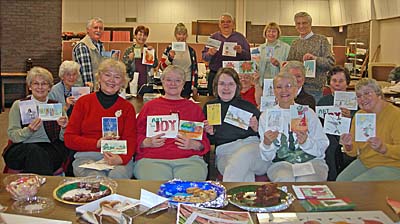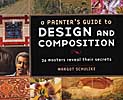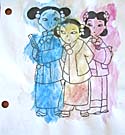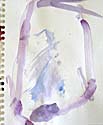Slumber party play-back
Labels: baby-sitting, family

Nita Leland's blog is about her creative and family life, including book reviews, art links and essays on color, creativity, watercolor, writing, teaching and other subjects.
Labels: baby-sitting, family
 Once in awhile I get a photo of my granddaughter, now almost four years old, that takes my breath away. Just had to share it. Her parents are going to a party tomorrow night and she has told them she wants to stay overnight at Grammy's house--for the first time. She has been to Colorado and Tennessee with her parents, but has never spent the night without them anywhere. Should be interesting. We've been transforming her mother's old room into Jenna's new room--I think she'll fall for that. She's very comfortable here, but it will be interesting to see what happens when the lights go out at bedtime.
Once in awhile I get a photo of my granddaughter, now almost four years old, that takes my breath away. Just had to share it. Her parents are going to a party tomorrow night and she has told them she wants to stay overnight at Grammy's house--for the first time. She has been to Colorado and Tennessee with her parents, but has never spent the night without them anywhere. Should be interesting. We've been transforming her mother's old room into Jenna's new room--I think she'll fall for that. She's very comfortable here, but it will be interesting to see what happens when the lights go out at bedtime.Labels: baby-sitting, family, little artist
 My son and I took in the Rembrandt exhibition at the Dayton Art Institute yesterday. For some reason I expected a small show, but it's a blockbuster and truly awesome. I tried to imagine the very small geographic area of the Netherlands as I studied paintings by the many skilled seventeenth-century artists on display in the show. Room after room of marvelous artworks, curated by subject, beginning with portraits of amazing depth and intelligence. The still lifes are rich and engaging, the landscapes luminous and atmospheric. Genre paintings of biblical times and contemporary life close the exhibit with Rembrandt's "Denial of Peter" as the dramatic finale. Interspersed in smaller spaces between painting exhibits are Rembrandt's etching and engravings, which are a worthy show unto themselves: "amazing" is all I can say about these small works. (Some have magnifying glasses attached to the wall for closer examination--what a great idea. Next time I go to a print show, I'll take my own.) There is still time until Jan. 7 to see the show in Dayton, so don't miss this rare opportunity to see works by the greatest of the great, Rembrandt. The show will move to Phoenix, Arizona and Portland, Oregon. For more about the artists and art, click the link above.
My son and I took in the Rembrandt exhibition at the Dayton Art Institute yesterday. For some reason I expected a small show, but it's a blockbuster and truly awesome. I tried to imagine the very small geographic area of the Netherlands as I studied paintings by the many skilled seventeenth-century artists on display in the show. Room after room of marvelous artworks, curated by subject, beginning with portraits of amazing depth and intelligence. The still lifes are rich and engaging, the landscapes luminous and atmospheric. Genre paintings of biblical times and contemporary life close the exhibit with Rembrandt's "Denial of Peter" as the dramatic finale. Interspersed in smaller spaces between painting exhibits are Rembrandt's etching and engravings, which are a worthy show unto themselves: "amazing" is all I can say about these small works. (Some have magnifying glasses attached to the wall for closer examination--what a great idea. Next time I go to a print show, I'll take my own.) There is still time until Jan. 7 to see the show in Dayton, so don't miss this rare opportunity to see works by the greatest of the great, Rembrandt. The show will move to Phoenix, Arizona and Portland, Oregon. For more about the artists and art, click the link above.Labels: art history, art museums, artist, rembrandt, still life
Labels: family




Labels: art organizations, art/craft
 This is the subtitle of Eric Maisel's A Writer's Paris. He makes a compelling case for getting to Paris any way you can and living there for awhile and making a commitment to your creative soul to do your creative work surrounded by the inspiration of this great city of the arts. The Paris Maisel describes doesn't sound all that different from the one I once knew--enchanting. The book is filled with charming illustrations--drawings, photos, graphics, and collages. It isn't just about Paris, though. It's about committing to your creative work.
This is the subtitle of Eric Maisel's A Writer's Paris. He makes a compelling case for getting to Paris any way you can and living there for awhile and making a commitment to your creative soul to do your creative work surrounded by the inspiration of this great city of the arts. The Paris Maisel describes doesn't sound all that different from the one I once knew--enchanting. The book is filled with charming illustrations--drawings, photos, graphics, and collages. It isn't just about Paris, though. It's about committing to your creative work. Labels: book reviews, books, creativity, travel, writing

Labels: watercolor
Labels: art history, artist, charley parker, lines and colors
Labels: palette, watercolor
 Ron Ranson on Skies (Studio Vista, 1998) is for landscape painters in any medium who love to feature skies. The book shows techniques mostly in watercolor, but does include instruction on some other media, along with excellent photographs of cloud formations and many wonderful sky paintings. This is a great reference for landscape painters. I'm a sky freak myself and love paging through this book to look at the photos and paintings.
Ron Ranson on Skies (Studio Vista, 1998) is for landscape painters in any medium who love to feature skies. The book shows techniques mostly in watercolor, but does include instruction on some other media, along with excellent photographs of cloud formations and many wonderful sky paintings. This is a great reference for landscape painters. I'm a sky freak myself and love paging through this book to look at the photos and paintings.  Colour and Light in Oils by Nicholas Verrall and Robin Capon (Batsford, 2004). The pages on Understanding Oils are very informative and user friendly, even to a beginner in oils like me. There aren't many swatches for visual comprehension, but the artwork throughout is dazzling, but not overwhelming as a possible goal for an artist to strive for. Verrall and Capon cover painting color and light, different types of subject matter and the working process, with a few demos scattered throughout the book in two or three stages.
Colour and Light in Oils by Nicholas Verrall and Robin Capon (Batsford, 2004). The pages on Understanding Oils are very informative and user friendly, even to a beginner in oils like me. There aren't many swatches for visual comprehension, but the artwork throughout is dazzling, but not overwhelming as a possible goal for an artist to strive for. Verrall and Capon cover painting color and light, different types of subject matter and the working process, with a few demos scattered throughout the book in two or three stages.
 The Digital Canvas: Discovering the Art Studio in Your Computer. (Abrams Studio, 2006.) This book by Jonathan Raimes almost makes me want to sell all my painting gear and just play with my computer. It's dazzling and I really think I could do it with this book as my text. The book has page after page of brilliant color effects with simple computer screen shots to show the tools for achieving them. Probably not for beginners, but definitely for creative computer artists.
The Digital Canvas: Discovering the Art Studio in Your Computer. (Abrams Studio, 2006.) This book by Jonathan Raimes almost makes me want to sell all my painting gear and just play with my computer. It's dazzling and I really think I could do it with this book as my text. The book has page after page of brilliant color effects with simple computer screen shots to show the tools for achieving them. Probably not for beginners, but definitely for creative computer artists.
 Barbara McGuire has written Embracing Child Art. (Krause, 2001) to give adults ideas on how to encourage a child's natural creativity and ultimately help them to make a few treasured objects. There are wonderful suggestions for guiding Little Artists and helping them create projects with their own art to last a lifetime. The best part of the book is page after page of wonderful examples of child art.
Barbara McGuire has written Embracing Child Art. (Krause, 2001) to give adults ideas on how to encourage a child's natural creativity and ultimately help them to make a few treasured objects. There are wonderful suggestions for guiding Little Artists and helping them create projects with their own art to last a lifetime. The best part of the book is page after page of wonderful examples of child art.
 Helen Van Wyk's Color Mixing the Van Wyk Way: A Manual for Oil Painters (Art Instruction Associates, 2000) has quickly become a classic since it was first published in 1995. She keeps the color concepts simple, emphasizing primarily color temperature and comparing a few basic palette choices for simple still lifes and portraits. This book would help beginners in oils to understand their colors and master color mixing of specific pigments.
Helen Van Wyk's Color Mixing the Van Wyk Way: A Manual for Oil Painters (Art Instruction Associates, 2000) has quickly become a classic since it was first published in 1995. She keeps the color concepts simple, emphasizing primarily color temperature and comparing a few basic palette choices for simple still lifes and portraits. This book would help beginners in oils to understand their colors and master color mixing of specific pigments.
 Helen Van Wyk's Favorite Color Recipes. (Art Instruction Associates, 2000) expands somewhat on the previous book and introduces a greater variety of subjects with color recipes in oil paints that are her recommendations for painting them. This book ale effects in this book are understood, the painter would be well advised to develop a more personal palette of colors.
Helen Van Wyk's Favorite Color Recipes. (Art Instruction Associates, 2000) expands somewhat on the previous book and introduces a greater variety of subjects with color recipes in oil paints that are her recommendations for painting them. This book ale effects in this book are understood, the painter would be well advised to develop a more personal palette of colors.
 Barron's Creative Painting Series: Color. (2005) by Gemma Guasch and Josep Asunción contains a wealth of useful information on color and numerous beautiful reproductions of masterpieces to illustrate the use of color throughout art history. I love that part of the book, but I don't think the demo paintings do it justice. Maybe it's just the design of the book. Check it out, though, because it has a lot to offer.
Barron's Creative Painting Series: Color. (2005) by Gemma Guasch and Josep Asunción contains a wealth of useful information on color and numerous beautiful reproductions of masterpieces to illustrate the use of color throughout art history. I love that part of the book, but I don't think the demo paintings do it justice. Maybe it's just the design of the book. Check it out, though, because it has a lot to offer.
Once again, thanks to McCallister's Art Store for providing books for my reviews.
Labels: art mediums, book reviews, books, child art, color, color mixing, color theory, computer, design, landscape, McCallister's, oil painting, painting, still life, temperature, watercolor, watercolor techniques
 Vicky Murry's Mastering Color: The essentials of color illustrated with oils. (North Light, 2006) This book offers solid color theory applicable to all media. The book is beautifully illustrated with swatches and paintings by the author. The section on supplies and equipment is concise with a nice comparison of different ways oil-painting techniques--direct, indirect, plein air and alla prima. The basic palette is limited and very effective. There's a nice little section on color schemes, a subject often neglected in painting books. Murry explores individual colors and introduces a few design concepts, with a variety of helpful hints along the way.
Vicky Murry's Mastering Color: The essentials of color illustrated with oils. (North Light, 2006) This book offers solid color theory applicable to all media. The book is beautifully illustrated with swatches and paintings by the author. The section on supplies and equipment is concise with a nice comparison of different ways oil-painting techniques--direct, indirect, plein air and alla prima. The basic palette is limited and very effective. There's a nice little section on color schemes, a subject often neglected in painting books. Murry explores individual colors and introduces a few design concepts, with a variety of helpful hints along the way.  A Painter's Guide to Design and Composition by Margot Schulzke (North Light, 2006)includes the work of twenty-six contemporary masters who describe their process of designing their artwork. This is a beautiful book with lots of demos and color illustrations, but I find it a little confusing. The design-and-composition objective tends to get lost in the plethora of different techniques. I enjoyed reading it, but probably won't include it in my personal art library.
A Painter's Guide to Design and Composition by Margot Schulzke (North Light, 2006)includes the work of twenty-six contemporary masters who describe their process of designing their artwork. This is a beautiful book with lots of demos and color illustrations, but I find it a little confusing. The design-and-composition objective tends to get lost in the plethora of different techniques. I enjoyed reading it, but probably won't include it in my personal art library.
 I love Jean Uhl Spicer's book, Bright & Beautiful Flowers in Watercolor (North Light, 2004.) If I were a flower painter, this is how I would want to do it. Spicer's supplies and equipment section is concise and complete. Her basic palette of colors is fairly limited and well balanced. The chapter on color covers the basics in such a way that I think beginners can grasp the concepts quickly. The chapter on composition isn't quite as accessible, but the remainder of the book, which includes various transparent watercolor techniques, tips and demonstrations, is very good. Way to go, Jean.
I love Jean Uhl Spicer's book, Bright & Beautiful Flowers in Watercolor (North Light, 2004.) If I were a flower painter, this is how I would want to do it. Spicer's supplies and equipment section is concise and complete. Her basic palette of colors is fairly limited and well balanced. The chapter on color covers the basics in such a way that I think beginners can grasp the concepts quickly. The chapter on composition isn't quite as accessible, but the remainder of the book, which includes various transparent watercolor techniques, tips and demonstrations, is very good. Way to go, Jean.
Labels: art mediums, book reviews, books, color, color schemes, design, landscape, oil painting, painting, still life, watercolor
Labels: tutorials, watercolor techniques





Labels: child art, family, little artist, watercolor